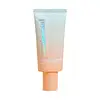What's inside
What's inside
 Key Ingredients
Key Ingredients

 Benefits
Benefits

 Concerns
Concerns

 Ingredients Side-by-side
Ingredients Side-by-side

Water
Skin ConditioningEthylhexyl Methoxycinnamate
UV AbsorberBenzophenone-3
UV AbsorberButyl Methoxydibenzoylmethane
UV AbsorberPhospholipids
Skin ConditioningButylene Glycol
HumectantPhenoxyethanol
PreservativeC15-19 Alkane
SolventTitanium Dioxide
Cosmetic ColorantAluminum Hydroxide
EmollientHydrogen Dimethicone
Caprylic/Capric Triglyceride
MaskingIsododecane
EmollientStearic Acid
CleansingCetyl Alcohol
EmollientCyclopentasiloxane
EmollientGlyceryl Stearate
EmollientPEG-100 Stearate
Polyacrylate-13
Polyisobutene
Polysorbate 20
EmulsifyingAllantoin
Skin ConditioningSoluble Collagen
HumectantSodium Benzoate
MaskingCitric Acid
BufferingSodium Hyaluronate
HumectantCI 77499
Cosmetic ColorantCI 77491
Cosmetic ColorantCI 77492
Cosmetic ColorantIsopropyl Titanium Triisostearate
EmollientParfum
MaskingMenthol
MaskingWater, Ethylhexyl Methoxycinnamate, Benzophenone-3, Butyl Methoxydibenzoylmethane, Phospholipids, Butylene Glycol, Phenoxyethanol, C15-19 Alkane, Titanium Dioxide, Aluminum Hydroxide, Hydrogen Dimethicone, Caprylic/Capric Triglyceride, Isododecane, Stearic Acid, Cetyl Alcohol, Cyclopentasiloxane, Glyceryl Stearate, PEG-100 Stearate, Polyacrylate-13, Polyisobutene, Polysorbate 20, Allantoin, Soluble Collagen, Sodium Benzoate, Citric Acid, Sodium Hyaluronate, CI 77499, CI 77491, CI 77492, Isopropyl Titanium Triisostearate, Parfum, Menthol
Water
Skin ConditioningAloe Barbadensis Leaf Juice
Skin ConditioningCucumis Sativus Fruit Extract
EmollientGlycerin
HumectantButyl Methoxydibenzoylmethane
UV AbsorberOctocrylene
UV AbsorberEthylhexyl Methoxycinnamate
UV AbsorberPolyacrylate Crosspolymer-11
Emulsion StabilisingStearic Acid
CleansingDimethicone
EmollientCyclopentasiloxane
EmollientSodium PCA
HumectantHyaluronic Acid
HumectantCentella Asiatica Extract
CleansingCamellia Sinensis Leaf Extract
AntimicrobialDipotassium Glycyrrhizate
HumectantIsopropyl Myristate
EmollientNiacinamide
SmoothingPEG-40 Hydrogenated Castor Oil
EmulsifyingCarbomer
Emulsion StabilisingHydrolyzed Collagen
EmollientTocopherol
AntioxidantPhenoxyethanol
PreservativeEthylhexylglycerin
Skin ConditioningWater, Aloe Barbadensis Leaf Juice, Cucumis Sativus Fruit Extract, Glycerin, Butyl Methoxydibenzoylmethane, Octocrylene, Ethylhexyl Methoxycinnamate, Polyacrylate Crosspolymer-11, Stearic Acid, Dimethicone, Cyclopentasiloxane, Sodium PCA, Hyaluronic Acid, Centella Asiatica Extract, Camellia Sinensis Leaf Extract, Dipotassium Glycyrrhizate, Isopropyl Myristate, Niacinamide, PEG-40 Hydrogenated Castor Oil, Carbomer, Hydrolyzed Collagen, Tocopherol, Phenoxyethanol, Ethylhexylglycerin
 Reviews
Reviews

Ingredients Explained
These ingredients are found in both products.
Ingredients higher up in an ingredient list are typically present in a larger amount.
Also known as Avobenzone, this ingredient is a chemical sunscreen filter that provides protection in the UV-A range.
Avobenzone is globally approved and is the most commonly used UV-A filter in the world.
Studies have found that avobenzone becomes ineffective when exposed to UV light (it is not photostable; meaning that it breaks down in sunlight). Because of this, formulations that include avobenzone will usually contain stabilizers such as octocrylene.
However, some modern formulations (looking at you, EU!) are able to stabilize avobenzone by coating the molecules.
Avobenzone does not protect against the UV-B range, so it's important to check that the sunscreen you're using contains other UV filters that do!
The highest concentration of avobenzone permitted is 3% in the US, and 5% in the EU.
Learn more about Butyl MethoxydibenzoylmethaneCyclopentasiloxane, or D5, is a silicone used to improve texture of products and trap moisture.
D5 is considered lightweight and volatile. Volatile means it evaporates quickly after application. Once evaporated, D5 leaves a thin barrier that helps keep skin hydrated.
It is also an emollient. Emollients help soften the skin and prevent water loss. Silicones create a silky texture in products. D5 helps other ingredients become more spreadable.
Studies show D5 is safe to use in skincare products. We recommend speaking with a skincare professional if you have concerns.
Learn more about CyclopentasiloxaneEthylhexyl Methoxycinnamate is an organic compound that provides UVB protection. It often goes by the more common name of octinoxate. It is created from methoxycinnamic acid and 2-ethylhexanol.
Ethylhexyl Methoxycinnamate absorbs UVB rays with wavelengths between 280-320 nm. UV absorbers protect your skin by using chemical reactions to convert UV rays into heat and energy.
UVB (290-320 nm) rays emit more energy than UVA rays. They are capable of damaging DNA, causing sunburns and are thought to be linked to skin cancer.
The state of Hawaii has banned sunscreens containing octinoxate due to its potential impact on coral reefs. More research is needed to bridge gaps in this research. The European Union allows higher levels of octinoxate in sunscreens than the US and Australia.
Ethylhexyl Methoxycinnamate is oil soluble. It is not stable and may lose efficacy when exposed to sunlight.
Learn more about Ethylhexyl MethoxycinnamatePhenoxyethanol is a preservative that has germicide, antimicrobial, and aromatic properties. Studies show that phenoxyethanol can prevent microbial growth. By itself, it has a scent that is similar to that of a rose.
It's often used in formulations along with Caprylyl Glycol to preserve the shelf life of products.
Stearic Acid is a fatty acid. It is an emollient, emulsifier, and texture enhancer.
As an emollient, stearic acid helps soften skin. It aids the skin's protective barrier by preventing water loss. It also provides a gentle cleansing effect without stripping away natural oils.
Stearic acid may also be used to enhance the texture of products. It can add volume and stabilize ingredients such as water and oil. This can help water and oil ingredients from separating.
Sources of stearic acid include animal or vegetable fats/oils such as coconut or shea. It can be naturally found in butter, cocoa butter, shea butter, vegetable fats, and animal tallow.
This ingredient may not be Malassezia folliculitis, or fungal-acne safe.
Learn more about Stearic AcidWater. It's the most common cosmetic ingredient of all. You'll usually see it at the top of ingredient lists, meaning that it makes up the largest part of the product.
So why is it so popular? Water most often acts as a solvent - this means that it helps dissolve other ingredients into the formulation.
You'll also recognize water as that liquid we all need to stay alive. If you see this, drink a glass of water. Stay hydrated!
Learn more about Water